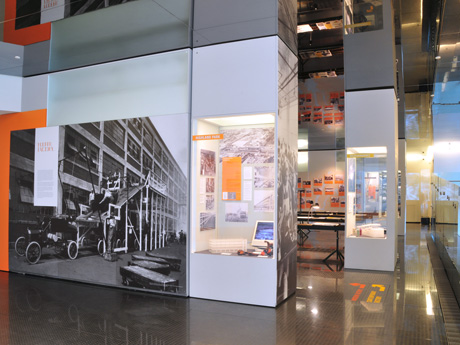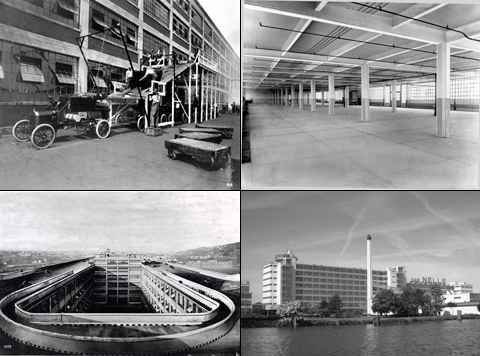The Skyscraper Museum is devoted to the study of high-rise building, past, present, and future. The Museum explores tall buildings as objects of design, products of technology, sites of construction, investments in real estate, and places of work and residence. This site will look better in a browser that supports web standards, but it is accessible to any browser or Internet device.
THE MODERN FACTORY

Photograph � Christopher Hall
The term modern as applied to factory design and construction has several meanings in the early 20th century. "Modern" factories were made of new materials. These contrasted with the older, traditional structures with thick masonry walls and dark, cramped workspaces. From the mid-19th century, iron, steel, and plate glass allowed for new types of utilitarian industrial buildings with expansive, open floors, large windows, and skylights. The major inventions came in the late 1890s with the introduction of metal-reinforced concrete. Developed in a range of patented systems which used a grid of widely spaced columns and concrete slab floors, these "daylight factories" had frames that could be filled with large steel sash or casement windows, allowing natural light to filter deep into the interior. Engineers and entrepreneurs such as Ernest L. Ransome, Wayss and Frietag, C.A.P. Turner, and Julius Kahn pioneered these inexpensive and innovative reinforced concrete structures, which were developed across the U.S. and Europe in response to manufacturing needs.

Top Left: Highland Park, Ford Factory, Albert Kahn Architect, Detroit, 1910. Courtesy Albert Kahn Associates.
Top Right: Interior View: Ford Motor Company Highland Park Plant, Michigan, 1918. The building annexed to the original factory, exterior view. Courtesy of Albert Kahn Associates.
Bottom Left: Fiat Lingotto Factory, Giacomo Matte-Trucco, Turin, Italy, 1916-23. Courtesy of Archivio e Centro Storico Fiat
Bottom Right: Van Nelle, The Skyscraper Museum
"Modern" factories also looked to improve production processes through mechanization and rationalization. By 1913, Henry Ford's Highland Park Plant assembly line could produce a Model T automobile every three minutes, establishing an international paradigm of efficiency. Likewise, the principles of Frederick W. Taylor promoted time-motion studies and "Scientific Management" techniques which accelerated the speed of mass production worldwide. Avant-garde European architects found the Modern factory to be a prime exemplar of the Machine Age. In their writings and projects, architects such as Walter Gropius, Eric Mendelsohn, and Le Corbusier celebrated its simplicity and functionalism, embracing it as a model for other building types-- from "machines for living" to the glass and steel skyscrapers of the International Style.
Featured in this exhibition are formal and structural experiments in poured concrete for the ramped circulation systems of Fiat's Lingotto and the Toni dairy factory; the gridded concrete frames of Highland Park, Bata, and Duval; the folded-concrete ceiling of Sainsbury; the glass fa�ades of Van Nelle; and the steel and glass integrated frame of Buckminster Fuller's proposed cotton mill. Together, they show that the factory-- as an icon of progress and a place of dynamic convergence between architecture and engineering-- came to epitomize the Modern aesthetic.
